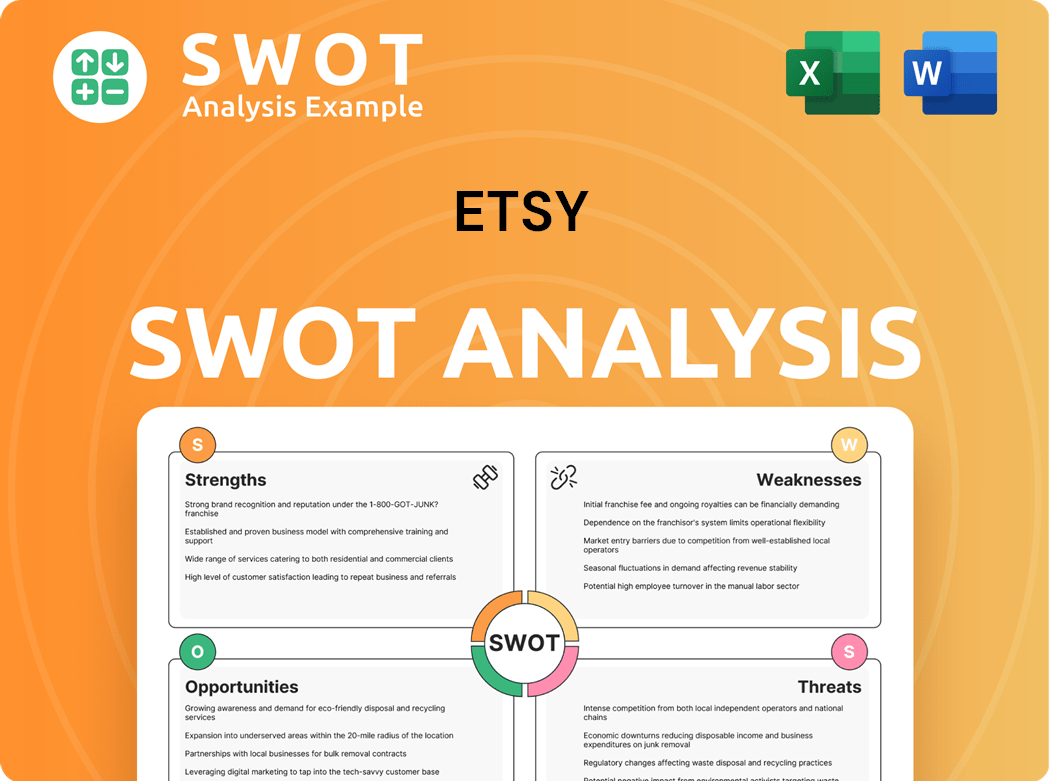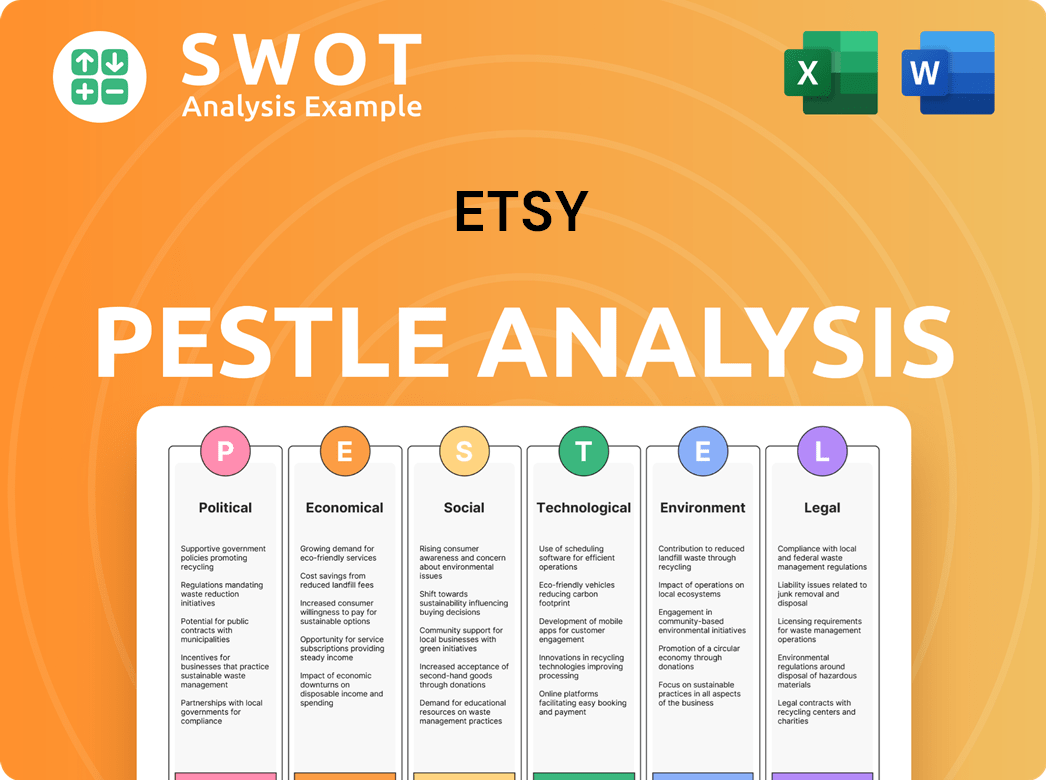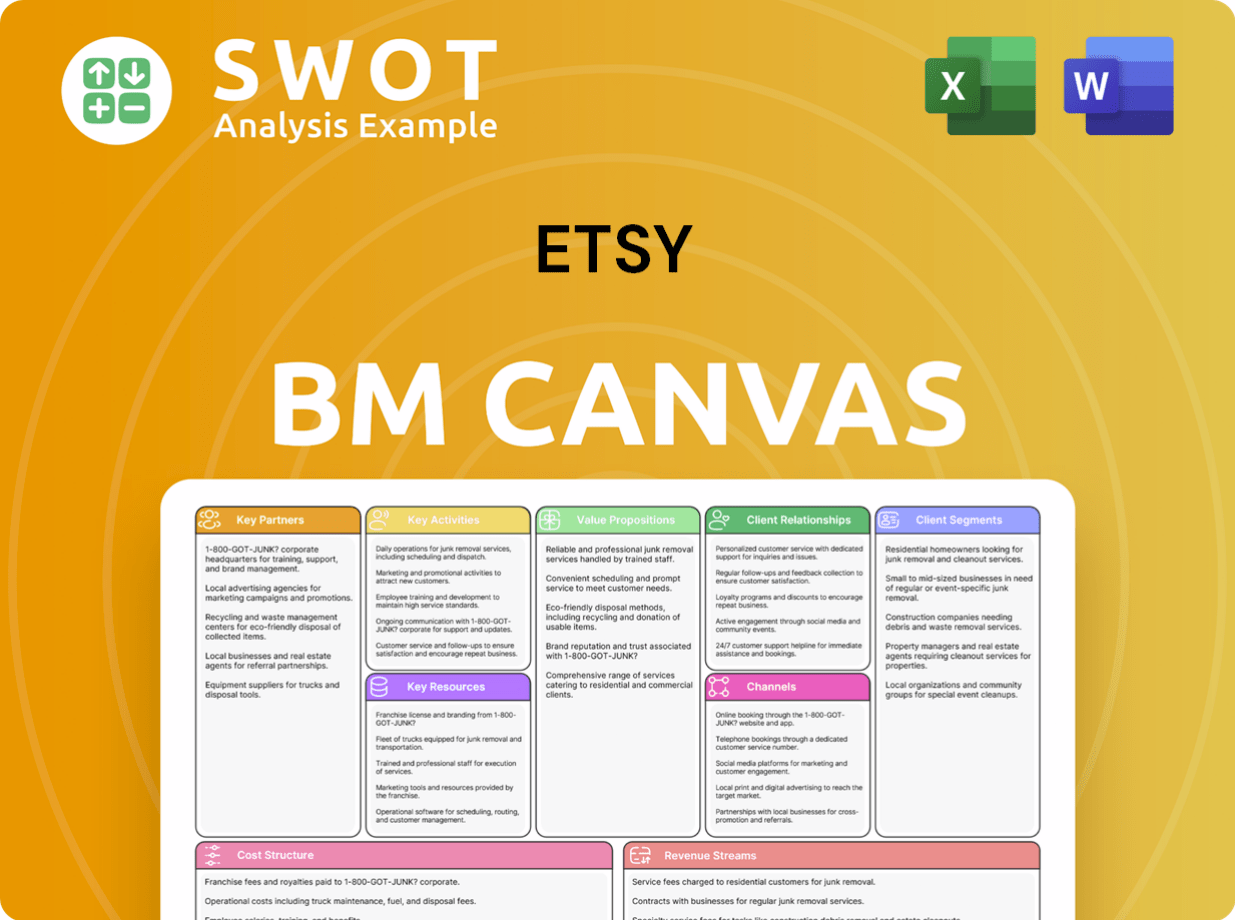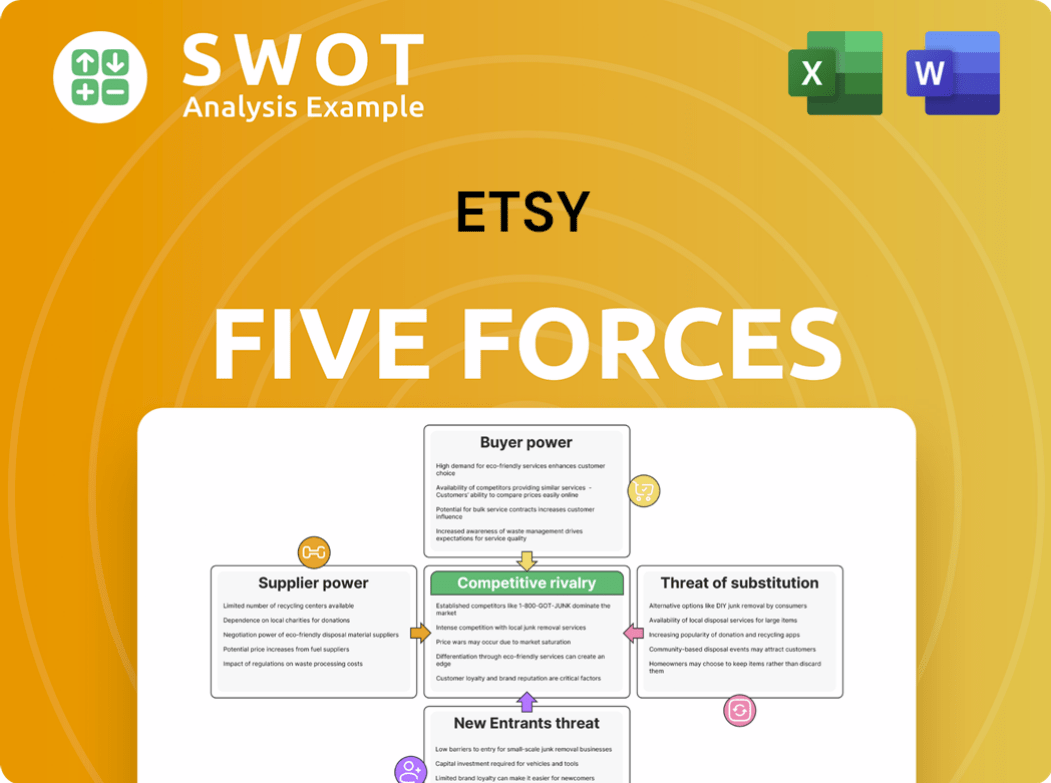Etsy Bundle
Who's Really Challenging Etsy in the E-commerce Arena?
Etsy, the go-to platform for unique, handmade, and vintage goods, has revolutionized how we shop. But in the bustling world of online retail, who are its biggest rivals, and how do they stack up? This exploration dives deep into the Etsy SWOT Analysis, examining the competitive landscape to reveal the strategies shaping the future of e-commerce.

Understanding the Etsy competitive landscape is crucial for anyone involved in e-commerce. This Etsy market analysis will dissect the key players in the online marketplace, comparing their strengths and weaknesses. We'll explore Etsy's competitors, from established giants to emerging small business platforms, providing insights into how Etsy maintains its edge in a competitive environment. Analyzing Etsy's financial performance compared to its rivals offers a comprehensive view of its market position and growth potential.
Where Does Etsy’ Stand in the Current Market?
Etsy's market position is distinct within the e-commerce sector, focusing on handmade, vintage, and craft supplies. This specialization sets it apart from general e-commerce platforms. As of early 2024, Etsy boasted 89.9 million active buyers and 7.4 million active sellers, highlighting its significant reach within its niche market.
The company's primary offerings include unique artisan goods, vintage items (at least 20 years old), and craft supplies, appealing to consumers seeking authenticity. Etsy has a substantial global presence, with a considerable portion of its business originating outside the United States. The platform's focus on unique items gives it a strong position, despite increasing competition from larger e-commerce players.
Etsy has refined its positioning over time, evolving beyond a simple craft marketplace. This evolution includes improvements to the buyer and seller experience, such as investments in marketing, search functionality, and seller tools. In 2023, the company reported revenue of $2.7 billion, demonstrating its financial health and market strength. For more insights, consider exploring the Marketing Strategy of Etsy.
Etsy operates as an online marketplace connecting buyers and sellers of handmade, vintage, and craft items. It provides a platform for sellers to list their products and for buyers to discover unique goods. The platform facilitates transactions, offering tools for both sellers and buyers to manage their activities.
Etsy's value proposition centers on offering a curated selection of unique, handcrafted, and vintage items. It provides a platform that supports small businesses and individual artisans, giving them access to a global customer base. For buyers, it offers a diverse range of distinctive products that are often unavailable elsewhere.
While precise market share figures for Etsy's specific niche are challenging to obtain, its dominance in the handmade and vintage categories is evident. The platform's large number of active buyers and sellers, coupled with its revenue, indicates a significant market presence. Etsy's focus on a specialized market differentiates it from broader e-commerce competitors.
Etsy has a substantial global presence, with a significant portion of its business originating outside the United States. This international reach allows Etsy to tap into diverse markets and customer bases. The company's ability to attract both buyers and sellers from around the world contributes to its competitive advantage.
Etsy's competitive advantages include its strong brand recognition, established community, and focus on a unique product selection. Its disadvantages include increased competition from larger e-commerce players, the potential for fluctuating seller quality, and the need to continually innovate to maintain its market position.
- Etsy's strong brand recognition in the handmade and vintage categories.
- A large and active community of buyers and sellers.
- Focus on unique, handcrafted, and vintage items.
- Competition from larger e-commerce platforms.
Etsy SWOT Analysis
- Complete SWOT Breakdown
- Fully Customizable
- Editable in Excel & Word
- Professional Formatting
- Investor-Ready Format

Who Are the Main Competitors Challenging Etsy?
The Etsy competitive landscape is multifaceted, encompassing a range of direct and indirect rivals vying for market share in the unique goods and handmade items sector. Understanding these Etsy competitors is crucial for analyzing the platform's position and future prospects. This Etsy market analysis reveals a dynamic environment where various players challenge its dominance.
Direct competitors primarily focus on similar niches, such as handmade and vintage products, while indirect competitors include larger e-commerce platforms and social media channels. The competitive pressures also come from individual sellers establishing their own direct-to-consumer (DTC) channels. The ongoing evolution of the e-commerce market requires continuous adaptation and strategic responses to maintain a competitive edge.
E-commerce competition is fierce, with several entities challenging the platform's position. The competitive dynamics are constantly shifting, requiring the platform to innovate and adapt to maintain its market share. Understanding the strengths and weaknesses of these rivals is essential for formulating effective strategies.
These platforms directly compete by offering similar products and services. They target the same customer base and often employ similar business models. Analyzing these competitors helps to understand the specific challenges and opportunities within the handmade and vintage goods market.
These competitors offer alternative ways for customers to purchase similar goods. They may not be direct marketplaces but still compete for consumer spending. Understanding indirect competitors helps to identify broader market trends and potential threats.
Major players in the e-commerce space, such as Amazon and eBay, also compete in the handmade and vintage markets. Their established customer bases and extensive resources pose significant challenges. Their strategies and market presence impact the overall competitive landscape.
Platforms like Instagram and Facebook Marketplace facilitate direct sales by creators. This bypasses traditional marketplace fees. The rise of social commerce presents a new dimension to the competitive environment, affecting how sellers and buyers interact.
The growth of direct-to-consumer brands and sellers using platforms like Shopify allows creators to establish independent e-commerce sites. This trend challenges traditional marketplace models. These sellers can control their brand and customer experience directly.
Craft fairs and local artisan markets provide an offline alternative for consumers. They offer a unique shopping experience and cater to those who prefer in-person purchases. These venues represent a segment of the market that the platform does not directly capture.
The Etsy competitors for handmade goods include platforms like ArtFire and Zibbet, which offer similar services, though on a smaller scale. Amazon Handmade, launched in 2015, presents a significant challenge due to its vast customer base and logistical capabilities. Etsy vs Amazon handmade comparison reveals that Amazon leverages its existing infrastructure to attract sellers, while the platform focuses on its established niche. Etsy market share analysis 2024 shows that the platform continues to hold a significant portion of the handmade and vintage market, but faces increasing competition from Amazon and others. Understanding Etsy competitive advantages and disadvantages is crucial for assessing its position. One of the Etsy seller alternatives includes eBay, which has a strong presence in vintage items. The platform's ability to adapt and innovate will be key to maintaining its competitive edge. For more information, you can read a Brief History of Etsy.
Several factors influence the competitive landscape. These include pricing strategies, marketing efforts, customer service, and the range of products offered. Understanding these factors is essential for analyzing the competitive dynamics.
- Pricing and Fees: Competitors' fee structures, including listing fees, transaction fees, and advertising costs, significantly impact sellers' profitability and choices.
- Market Reach and Customer Base: The size and demographics of the customer base are critical. Platforms with larger audiences offer greater visibility for sellers.
- Seller Tools and Support: The availability of tools for managing shops, marketing products, and providing customer service influences sellers' experience.
- Product Range and Specialization: The breadth and depth of product offerings, including unique or specialized items, attract different customer segments.
- Brand Reputation and Trust: The platform's reputation for quality, authenticity, and customer satisfaction affects consumer trust and loyalty.
Etsy PESTLE Analysis
- Covers All 6 PESTLE Categories
- No Research Needed – Save Hours of Work
- Built by Experts, Trusted by Consultants
- Instant Download, Ready to Use
- 100% Editable, Fully Customizable

What Gives Etsy a Competitive Edge Over Its Rivals?
Understanding the Owners & Shareholders of Etsy is crucial to grasping its competitive advantages within the dynamic e-commerce sector. The company's success is built on a foundation of unique strengths that have allowed it to carve out a significant niche in the online marketplace. This analysis delves into the core elements that define its competitive edge, from its brand recognition to its operational efficiencies.
Etsy's competitive landscape is shaped by its distinctive focus on handmade, vintage, and unique items, setting it apart from broader e-commerce platforms. This specialization has cultivated a loyal community of buyers and sellers, fostering a powerful network effect. The platform's technological infrastructure, tailored to the needs of creative entrepreneurs, further enhances its appeal and supports its market position. The company's strategic moves, including acquisitions like Depop and Reverb, also play a key role in its competitive strategy.
A comprehensive Etsy market analysis reveals that the company's advantages are multifaceted, contributing to its sustained growth and market share. These advantages are not only about the products sold but also about the community it has built and the tools it provides to its sellers. Understanding these factors is vital for anyone looking to assess its long-term potential and how it stands against its rivals in the e-commerce competition.
Etsy's strong brand equity is a significant advantage, recognized as the leading platform for handmade, vintage, and unique items. This specialized focus differentiates it from larger e-commerce players. This targeted approach allows it to attract a specific customer base seeking distinctive products, fostering customer loyalty and engagement.
The platform benefits from a powerful network effect, driven by its large base of active buyers and sellers. In 2023, it had 89.9 million active buyers and 7.4 million active sellers. This large community attracts more participants, creating a self-reinforcing cycle of growth and engagement. The community-centric approach enhances customer loyalty.
Etsy's platform is specifically designed for creative entrepreneurs, offering tools for shop management, marketing, and analytics. These tools cater to the needs of small businesses, enhancing their ability to succeed on the platform. Continuous innovation in its platform and user experience contributes to its stickiness.
The company benefits from economies of scale, allowing it to invest in marketing and technology more effectively than smaller niche platforms. This efficiency supports its competitive position and enables it to expand its reach and enhance its offerings. These efficiencies contribute to its financial performance compared to competitors.
Etsy's competitive advantages are further enhanced by its commitment to fostering a supportive community and its strategic acquisitions. These factors contribute to its strong market positioning in the e-commerce sector. However, it faces potential threats from larger e-commerce players and shifts in consumer preferences.
- Acquisitions of Depop and Reverb have expanded its focus on unique goods.
- Commitment to supporting sellers through forums and resources enhances loyalty.
- Continuous innovation in platform features keeps sellers engaged.
- Strong brand reputation attracts both buyers and sellers.
Etsy Business Model Canvas
- Complete 9-Block Business Model Canvas
- Effortlessly Communicate Your Business Strategy
- Investor-Ready BMC Format
- 100% Editable and Customizable
- Clear and Structured Layout

What Industry Trends Are Reshaping Etsy’s Competitive Landscape?
The e-commerce industry, particularly the segment occupied by Etsy, is dynamic, influenced by technological advancements, shifting consumer preferences, and evolving regulatory landscapes. Understanding the Etsy competitive landscape requires a close look at industry trends, potential challenges, and emerging opportunities. The platform's success hinges on its ability to adapt and innovate in this rapidly changing environment.
Etsy market analysis reveals that the platform's focus on handmade, vintage, and unique items positions it distinctively within the broader e-commerce ecosystem. However, this niche also presents challenges, including intense competition and the need to maintain a strong brand identity. The future outlook depends on Etsy's strategic responses to these factors, including its ability to leverage emerging technologies and capitalize on evolving consumer demands. For a deeper dive into their growth strategy, you can read about the Growth Strategy of Etsy.
Key trends shaping the Etsy competitive landscape include the rise of social commerce, the increasing importance of personalization, and the growing demand for sustainable and ethically sourced products. AI and machine learning are being used to enhance search and product recommendations. Regulatory changes concerning data privacy and intellectual property also influence the market dynamics.
Challenges include increased competition from larger platforms and direct-to-consumer brands. Potential saturation in the handmade market and rising shipping costs could impact small sellers. Maintaining the authenticity of handmade items and addressing algorithmic bias are also significant concerns. The need to navigate complex global regulations presents an ongoing hurdle.
Opportunities include expansion into emerging markets where demand for unique products is growing. Product innovations, such as augmented reality tools for visualizing products, and strategic partnerships can enhance the platform's offerings. Leveraging community features and focusing on curated marketplaces can further differentiate from competitors.
Strategies include continued investment in seller tools, global expansion, and leveraging the platform's community aspect. Enhancing search functionality and personalization through AI can improve user experience. Adapting to regulatory changes and maintaining a strong brand identity are also critical for long-term success.
Etsy's competitive landscape is shaped by its unique focus on handmade, vintage, and craft items, setting it apart from broader e-commerce platforms. However, this specialization also means Etsy faces specific challenges, including competition from platforms like Amazon Handmade and eBay. Understanding the advantages and disadvantages is crucial for evaluating Etsy's market position and potential for growth.
- Advantages: Strong brand identity centered around unique, handcrafted goods. A dedicated community of buyers and sellers fosters loyalty. Focus on niche markets allows for targeted marketing and product offerings.
- Disadvantages: Dependence on small businesses can lead to inconsistent product quality. Shipping costs can be higher compared to larger retailers. Competition from larger platforms with more resources.
- Market Share: As of late 2024, Etsy's market share in the online marketplace for unique goods is estimated at around 10-15%, showing steady growth.
- Financial Performance: In the first quarter of 2024, Etsy reported revenue of approximately $640 million, reflecting a moderate increase compared to the same period in the previous year.
Etsy Porter's Five Forces Analysis
- Covers All 5 Competitive Forces in Detail
- Structured for Consultants, Students, and Founders
- 100% Editable in Microsoft Word & Excel
- Instant Digital Download – Use Immediately
- Compatible with Mac & PC – Fully Unlocked

Related Blogs
- What are Mission Vision & Core Values of Etsy Company?
- What is Growth Strategy and Future Prospects of Etsy Company?
- How Does Etsy Company Work?
- What is Sales and Marketing Strategy of Etsy Company?
- What is Brief History of Etsy Company?
- Who Owns Etsy Company?
- What is Customer Demographics and Target Market of Etsy Company?
Disclaimer
All information, articles, and product details provided on this website are for general informational and educational purposes only. We do not claim any ownership over, nor do we intend to infringe upon, any trademarks, copyrights, logos, brand names, or other intellectual property mentioned or depicted on this site. Such intellectual property remains the property of its respective owners, and any references here are made solely for identification or informational purposes, without implying any affiliation, endorsement, or partnership.
We make no representations or warranties, express or implied, regarding the accuracy, completeness, or suitability of any content or products presented. Nothing on this website should be construed as legal, tax, investment, financial, medical, or other professional advice. In addition, no part of this site—including articles or product references—constitutes a solicitation, recommendation, endorsement, advertisement, or offer to buy or sell any securities, franchises, or other financial instruments, particularly in jurisdictions where such activity would be unlawful.
All content is of a general nature and may not address the specific circumstances of any individual or entity. It is not a substitute for professional advice or services. Any actions you take based on the information provided here are strictly at your own risk. You accept full responsibility for any decisions or outcomes arising from your use of this website and agree to release us from any liability in connection with your use of, or reliance upon, the content or products found herein.